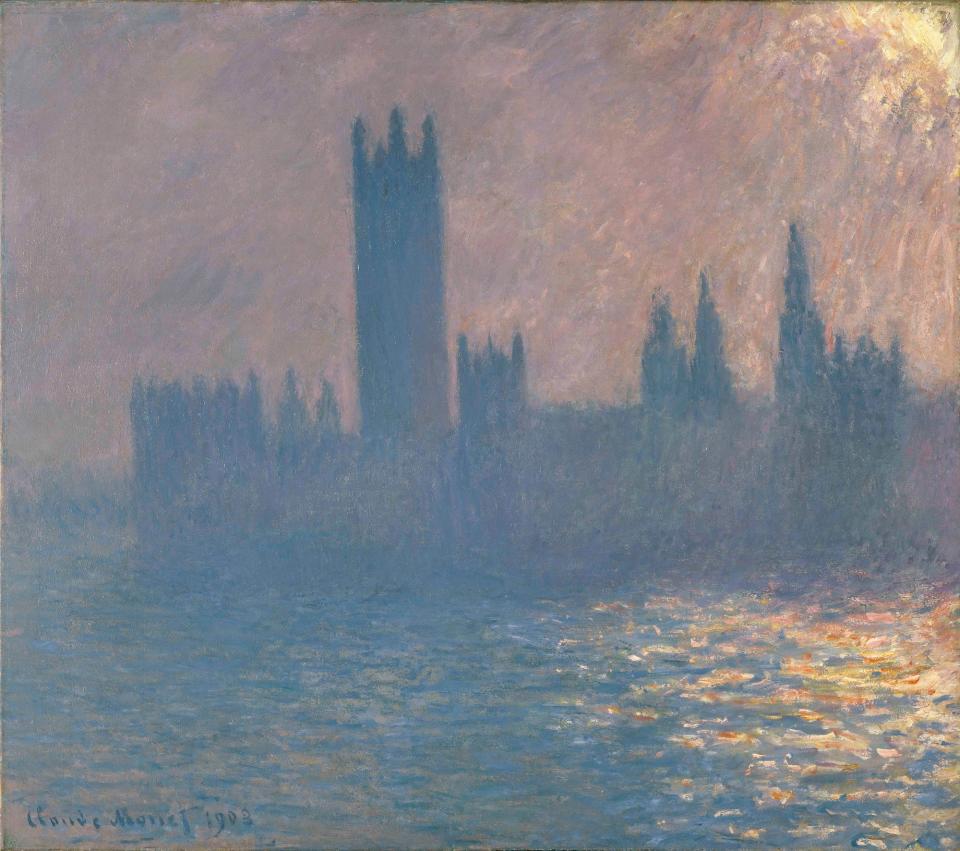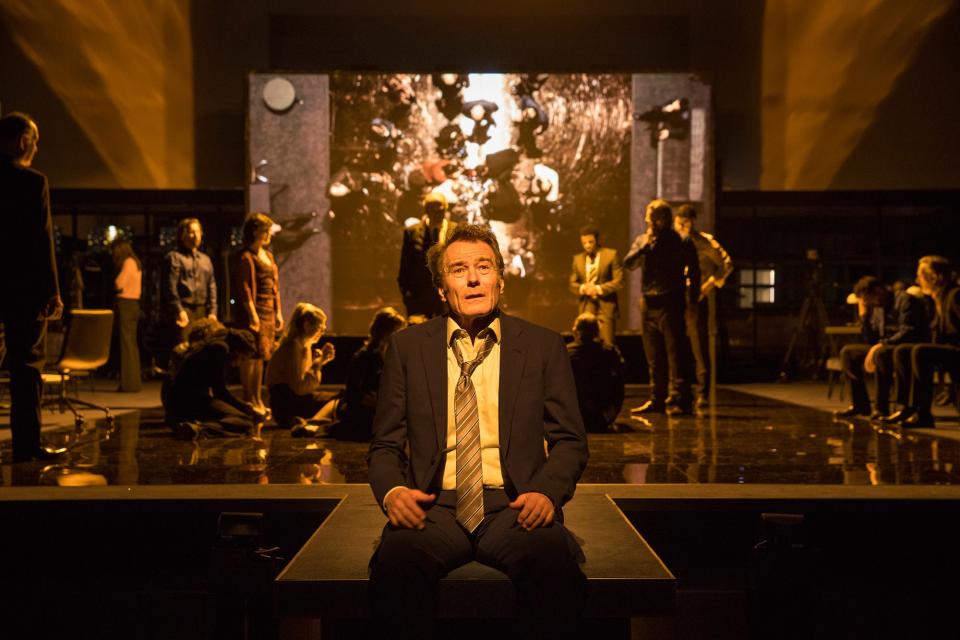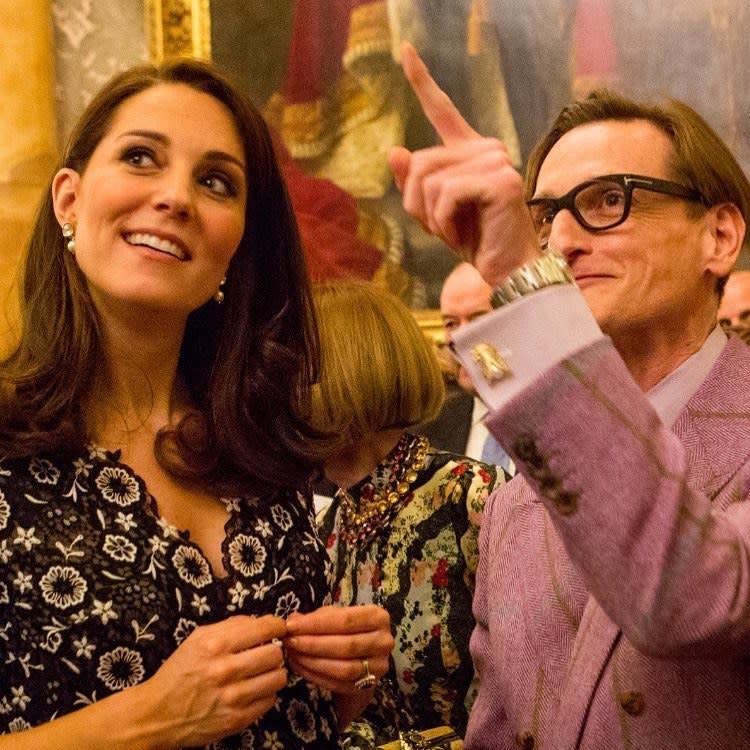From Buckingham Palace to the National Theatre, Hamish Bowles Takes London by Storm
What a whirlwind long weekend this has been! I haven’t done the full sweep of the London collections for several seasons, which means that an entirely new generation of design talent has sprung up in my absence.
So alongside the capital’s established design masters—including Christopher Bailey giving a poignant rainbow-flag, LGBTQ-celebratory swan song for Burberry set to the plaintive tones of Jimmy Somerville, and Christopher Kane celebrating Alex Comfort’s 1972 tome The Joy Of Sex—the collections were invigorated by the work of designers including Richard Malone, Matty Bovan, Molly Goddard, and Halpern. I was also enthralled by the thoughtful work of Loverboy’s Charles Jeffries, who showed during London Men’s Fashion Week, and the combination of it all confirmed the wealth of talent in this city.
And of course there was the electric thrill of the Richard Quinn show, where a plump black velvet cushion on a front row seat (between the London Fashion Council’s chief executive Caroline Rush and our own Anna Wintour) was tagged, mysteriously, only “VIP GUEST.” You cannot imagine the excitement when Her Majesty Queen Elizabeth II appeared, a diminutive figure with miraculously pretty skin, dressed in ice-blue tweed discreetly bedazzled with crystals (orchestrated by Angela Kelly) and a whopping diamond brooch and accessorized with black gloves. Richard’s collection, centered around his own throwback 1950s-style floral scarf prints, had a great energy to it, although what HM made of the chintz-allover balaclava look and the Bacofoil lamé opera coats I can’t quite imagine; it certainly wasn’t Norman Hartnell, even though the revered late dressmaker-by-appointment would have found those prints very familiar. After the show, we all stayed as the Queen rose to give a charming speech about the wonders of Britain’s fashion design and craft skills, from the tweed-weavers of the Hebrides to the lace-makers of Nottingham and (a quaint touch, this) Carnaby Street, before presenting Richard with the inaugural Queen Elizabeth II Award for British Design, appropriately enough featuring a pretty Queen Elizabeth rose, like something for the Rosenkavalier to present. Richard was verklempt, his parents were verklempt, I was verklempt.

The royal-watching did not stop there. The unstoppable force that is Livia Firth invited me to help orchestrate the sustainable Commonwealth Fashion Exchange project that she initiated, which was to be installed for one night only—at Buckingham Palace, no less—before transferring to Australia House. Livia, through her Eco Age initiative, had researched design talent in all 53 of the Commonwealth countries, from Canada and Australia to Kiribati and Tuvalu. (I know—I had to consult a map, too.) Some of the smaller nations that don’t have an established fashion industry were invited to collaborate with other countries, contributing jewelry, textiles, or embellishments that showcased indigenous craft. We had a day to install in several of the State Rooms at Buckingham Palace, which were created in 1825 by John Nash for the aesthetically minded George IV. (Nash also worked as a theater designer, and the progression of the rooms and their impact has a powerfully theatrical quality—so they provide an unparalleled showcase for statement fashion.) I arranged the clothes in thematic and what I hope were complementary groupings, and there were wonderful serendipities during the installation—the Maltese designers Charles and Ron’s black-and-white ballgown with its cuffs of Maltese lace, for instance, was placed next to some extraordinary Dutch portraits of wealthy burghers and their wives in black robes and white lace collars and cuffs. Meanwhile, the Samoan designer Afa Ah Loo’s own ball gown of vivid florals and bright-green silk sang in the Green Drawing Room, with its green Sèvres porcelain originally commissioned for the French royal family, its 18th-century commodes set with carved hard stone fruit and flowers, and the carnival razzle-dazzle of the two 18-year-old Iridescent fashion designers’ yellow satin and ostrich-plume ensemble (in collaboration with Granada’s Neisha La Touche) looked dramatic framed against the arsenic green draperies. It was moving to appreciate how global fashion truly is, and how much talent and skill flourishes around the globe, and the many indigenous crafts that need to be nurtured and revived. The thoroughly engaging royal ladies HRH the Duchess of Cambridge and HRH the Countess of Wessex were the evening’s guests of honor and seemed genuinely enthralled by the exhibition. It was a very great delight to meet them both.
Meanwhile, the festivities continued when Edward Enninful and Naomi Campbell hosted British Vogue’s Tiffany-sponsored party at the newly unveiled Annabel’s nightclub, now set in a ravishing mid-18th-century mansion on Berkeley Square (adjacent to the original establishment of that name) and spectacularly decorated with a rose-bowered treillage bar, a vast covered conservatory, and an exotic subterranean bar with coppery palm trees. Fashionistas, actors from the evening’s BAFTAs, and hipsters and DJs including Fat Tony and Virgil Abloh made sure the party rollicked late into the night. Luckily I had the promise of my palatial suite at the Bulgari hotel in Knightsbridge to finally lure me home.

Because I can’t let the grass grow, I raced to the Royal Academy to see “Charles I: King and Collector” and the exhibition dedicated to his son, “Charles II: Art and Power” at the Queen’s Galleries. That Merry Monarch inherited his father’s passion for art, but his collecting instincts seemed to focus on the painterly display of nubile female flesh. The court beauties, revealing only slightly less bosom in their tumbling pseudo-classical draperies, ringlets, and pearls, have a marshmallow allure of their own in portraits by Sir Peter Lely and Sir Godfrey Keller. Tate Britain’s “Impressionists in London” (through May 8), meanwhile, tells the story of the artists who fled the bloody horrors of the Franco-Prussian War and the brutal uprisings that ensued for the serenity of London across La Manche, where they reveled in swaths of green lawn and well dressed figures going about their lives. Naturally I cannot get enough of James (née Jean-Jacques) Tissot (who Anglicized his name in homage to his adopted land) and delighted in delightfully dressed beauties languishing at picnics, on crowded yachts, or preening at a ball or concert. The sculptors Jean-Baptiste Carpeaux and Jules Dalou brought his bravura talents to portrait busts of British aristocrats, while Monet reveled in the foggy light over the Thames and the Houses of Parliament.
Oh, and I dashed to the Wigmore Hall for the wondrous Prague-based Scalpa Quartet, performing Janácek and Korngold (the latter with pianist Melvyn Tan) to absolute perfection, and to the National Theatre twice, catching the new stage-musical adaptation of Pinocchio and writer Lee Hall’s adaptation of Paddy Chayefsky’s 1976 movie Network, set in the world of network television in the aftermath of Vietnam and Watergate. This thought-provoking theatrical experience is brilliantly staged by the always-innovative team of director Ivo van Hove and his designer Jan Versweyveld and showcases a formidably good Bryan Cranston in the Howard Beale role (a retiring newscaster going through an existential crisis in real time on television) originated on-screen by Peter Finch, a steely Michelle Dockery as the blood-curdling Diana Christensen (unforgettably portrayed by Faye Dunway on celluloid), and Douglas Henshall as the hapless Max Schumacher. The prescience of this story, intended as satire in the mid-’70s and all too real in 2018 America, beggars belief. It is no wonder that it is one of the hottest tickets in town. And in a last gasp I went to see Dennis Kelly’s astonishing new play Girls and Boys at the Royal Court, a page-turning one-woman piece with many a twist and turn, showcasing Carey Mulligan in entirely electrifying form.


